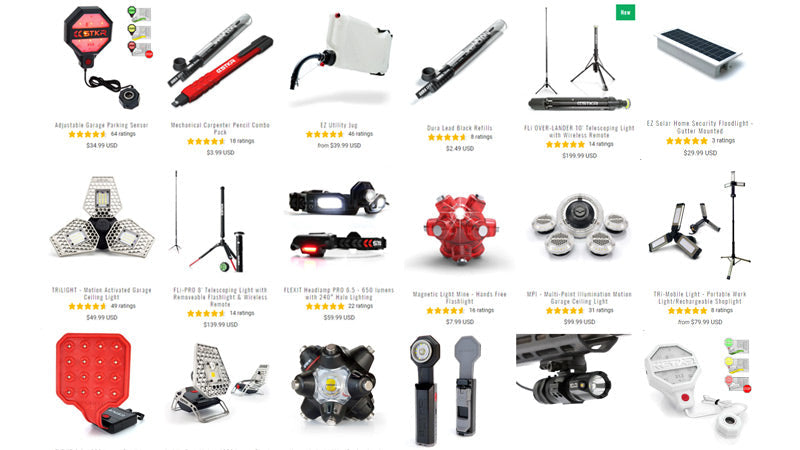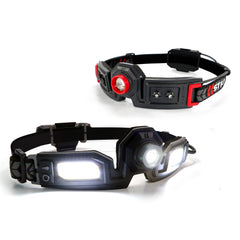
What Emergency Supplies Should I Have at Home
Share
Your home probably has everything you need to sustain your daily routine. But what if these supplies become useless due to natural calamities and other hazardous conditions?
This is why you should have a dedicated set of emergency supplies at home. These include items essential for basic survival, safety, and protection from further damage or other adverse effects of the circumstance that depleted your regular provisions.
Simply put, the emergency supplies you should keep inside your home should encompass food and water, a reliable light source, communication devices, and tools for survival. Keep them in one bag, often referred to as an emergency or bug-in bag.
If you want to learn more about items that go inside your emergency bag, stick around and find out.
Why Should You Have Emergency Supplies at Home?
Survival and safety – these are the two primary reasons why you should have emergency supplies at home.
When disasters strike, our instinct is deduced to saving lives rather than trivial items around the house. Imagine if a hurricane hits your home. Instead of going to the pantry, the kitchen, and the garage to assemble some of the essential survival tools, you simply get your survival bag and head to a safe zone. It saves you time, and in retrospect, it could save lives.
In the same way, if you find yourself in real danger, like getting trapped in a pile of debris or a confined but compromised space, you can still ask for help if you have a functional phone or at least a loud safety whistle.
What Are the Top 10 Items in an Emergency Kit?
When it comes to your emergency kit, you don’t have to fill it with things that suit your liking when it comes to surviving comfortably.
You need to consider are the essential items that can sustain you for at least three days.

Photo by GLOBENCER on Unsplash
1. Drinking-Water
You can survive for days without food but not without water.
Hydration is a vital part of survival. If you don’t drink water for hours, let alone days, it could have serious damage to your tissues.
So, make sure to prepare at least three gallons of water per person. This amount will most likely last for three days. Add more bottles if possible. It may not even be a bad idea to have a ‘life straw’-style water filter on hand just in case.
2. A Good Flashlight
Traditional flashlights are often bigger and require a larger set of batteries.
While it is perfectly fine to have this type of flashlight in your emergency kit, you can certainly do better with emergency-specific flashlights that last longer, provides brighter light, and are more portable and durable.
You can choose from the following STKR Concepts portable lights if you’re looking for reliable emergency lights.
Why should you wear a headlamp during emergencies?
Simple, it’s portable and keeps your hands free, which is essential, and you may need to maximize your tactile sense for survival.
Although you may be concerned about how headlamps only provide tunnel vision, the FLEXIT headlamps offer a straightforward solution to this problem.
FLEXIT incorporated 240° halo lighting into its headlamps that generate light on a wider scale. It also has a red night vision and an adjustable spotlight that makes focusing light more efficient.
With about 650 true lumens and a runtime of up to 55 hours, you can confidently find your way out of the emergency situation you’re in.
If you want to learn more about lumens and how they work, just visit our article here.
Illumidome Mini Waterproof Lantern
When the emergency situation involves lots of water due to consistent rain pouring or flooding, keeping your light becomes a critical matter.
Good thing STKR Concepts has the Illumidome Mini Waterproof Lantern. This portable little device can function even on top of the water. It is lightweight, durable, and has dual light array options. Also, it gives off 220 true lumens for about 100 hours of runtime.
If your emergency bag is slightly smaller, you can always go for a more compact flashlight such as the FLEXIT pocket light.
This nifty little lighting device produces light with about 650 total true lumens for up to 72 hours. It’s weather-resistant, rechargeable, and can be placed anywhere you like. You can hook it, hold it, clip it in your pocket, or let it stand free on the surface.
3. First Aid Kit
Injuries and infections can be inevitable during emergencies. However, the severity can be toned down if you have a first aid kit in your bag.
Make sure to have the following items in your kit.
- Bandages and gauze pads
- Antiseptic spray/liquid disinfectant
- Cotton
- Allergy medications
- Scissors and tweezers
- Safety pins
- Adhesive tapes

Photo by Alejandro Piñero Amerio on Unsplash
4. Multipurpose Tool
Having a multipurpose tool like the Swiss Army Knife or Leatherman multitool in your emergency supplies increases your chances of survival.
Multipurpose tools contain essential devices from a small knife, screwdriver, can opener, scissors, and more.
For example, if you need to cut or unscrew something to get out of a bad situation, you have a selection of tools in the palm of your hand.

Image by bluebudgie from Pixabay
5. Whistle
A whistle is a standard tool included in all types of emergency bags. However, if you are stranded or stuck in an obscure area in your home, shouting will do you no good.
On the other hand, using a whistle will most likely catch the attention of rescuers. So find an emergency whistle instead of an ordinary one.
Emergency whistles produce louder and clearer sounds with minimal blowing effort.

Photo by Les Argonautes on Unsplash
6. Food
Food items suitable for emergencies are not easily perishable and can remain edible under harsh conditions. Therefore, for your emergency food stock, you can rely on the following:
- Canned meat
- Canned veggies and soup
- Dried fruits
- Meat jerky
- Nuts and trail mixes
- Energy bar
- Crackers

Photo by Everyday basics on Unsplash
7. Communications devices
Retaining communication is crucial during an emergency.
While you may likely have your cell phone around you during these times, it is still best to keep an extra power bank and charge cable in your emergency bag. Make sure the power bank is fully charged.
At least, if your phone has drained its batteries, you can still connect with local rescuers with the backup power source.
Another great device to consider is having an FRS radio. They are small radios that are marketed as camping or even kids walkie talkies. They are short-distance communicators that usually all share the same 22 channels. Some even come with news and weather channels.

Photo by Pars Sahin on Unsplash
8. Blanket
A blanket has multiple purposes aside from providing warmth at night or during cold seasons.
You can use it to protect yourself from the heat of the sun or turn it into a bindle bag for other items that don’t fit your bug-in bag. Since it has plenty of uses, make sure to choose a blanket that is both comfortable and durable.

Image by kropekk_pl from Pixabay
9. Personal Effects
You simply can’t miss the necessary toiletries in your emergency supplies at home. Hygiene is still crucial during emergencies. The last thing you want to have is an infection from floodwaters or other hazardous resources.
Keep the following items in your bag:
- Tissues
- Toothbrush and toothpaste
- Antiseptic wipes
- Deodorant
- Shaving razor

Image by Christoph Schütz from Pixabay
10. Rope
Including a rope in your emergency bag is a wise decision.
A rope can be used in many ways. For example, you can use it to tie down several loads, create a make-shift shelter along with your blanket, or use them for lashing supplies.
More often than not, a rope is used multiple times in survival. Hence, it is pretty logical to keep them in your emergency bag.
Summary
Emergency supplies at home are not just optional items you should store in a single bag. They are must-haves and should be taken with utmost care and value.
Although it could feel like a hassle to prepare these items, it still makes sense to have them available, considering no one can predict your safety from natural and manmade disasters.
And as people often say, it’s better to have it and not need it than to need it and not have it.
So, if you’re slacking off a bit from preparing your home survival bag, it’s about time to pick up your pace and interest in the emergency supplies you’ll need for safety and survival.






